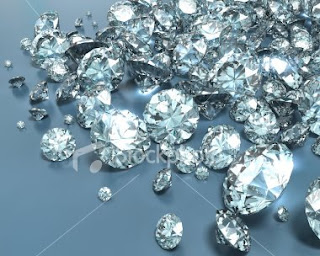75th Post
 photo courtesy of Bill Ely.
photo courtesy of Bill Ely.This is my diamond post. 75 is usually represented by Diamonds. So let's talk about them!
The Four C's
CARAT is the diamond weight.
- Carat is a measure of weight not of size.
- One carat is equivalent to 200 milligrams.
- One carat can also be divided into 100 “points.” A .75 carat diamond is the same as a 3/4 carat diamond.
- Cut and mounting can make a diamond appear larger or even smaller than its actual weight.
CLARITY How many flaws {inclusions} does the diamond have?
- Naturally-occurring features {inclusion} provide a special fingerprint within the stone.
- Inclusions may look like tiny crystals, clouds or feathers.
- The position of inclusions can affect the value of a diamond.
- Inclusions are ranked on a scale of perfection, known as clarity.
- Some inclusions can be hidden by a mounting, thus having little effect on the beauty of a diamond. An inclusion in the middle or top of a diamond could impact the dispersion of light, sometimes making the diamond less brilliant.
- The greater a diamond's clarity, the more brilliant, valuable and rare it is.
COLOR How colorless is the diamond?
- Diamonds are found in almost every color of the rainbow, but white-colored diamonds remain most popular.
- Truly colorless stones are treasured for their rarity.
- Diamonds also naturally come in intense shades of blue, green, yellow, orange, pink or red.
- These diamonds are called ‘colored fancies’ and are extremely rare and highly treasured.
CUT is the shape the diamond is cut into.
- Nature determines so much about a diamond, but it takes a master cutter to reveal the stone’s true brilliance, fire and ultimate beauty.
- Diamonds that are cut too deep or too shallow lose or leak light through the side or bottom, resulting in less brilliance and it loses its value.
- Cut also refers to shape—round, square, pear, or heart for example.
- A round diamond is symmetrical and capable of reflecting nearly all the light that enters. It is the most brilliant.
- Non-round shapes, are called fancy cuts.
Diamond Facts
- Diamonds were formed long before the dinosaurs were here. The youngest diamond is about 900 million years old. The oldest was formed over 3 billion years ago.
- Diamonds are like snowflakes, no two are alike.
- The rarest diamond color is red.
- The first diamonds came from India over 2800 years ago.
- Each stone usually loses about half of its weight during the cutting and polishing phase.
- Less than 5% of all the diamonds made into jewelry are larger than one carat.
Happy Reading,
The Four C'S and Diamond facts taken in part from A Diamond Is Forever.
